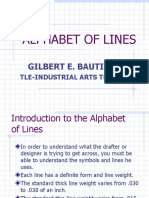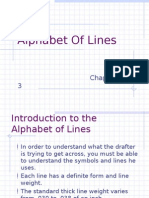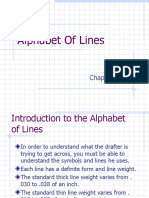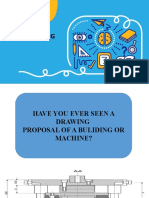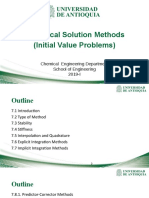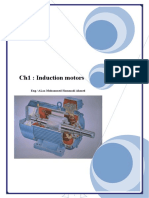Alphabet of Lines
Alphabet of Lines
Uploaded by
chloewdevansCopyright:
Available Formats
Alphabet of Lines
Alphabet of Lines
Uploaded by
chloewdevansOriginal Description:
Original Title
Copyright
Available Formats
Share this document
Did you find this document useful?
Is this content inappropriate?
Copyright:
Available Formats
Alphabet of Lines
Alphabet of Lines
Uploaded by
chloewdevansCopyright:
Available Formats
ALPHABET OF LINES – used to make a drawing neater and clearer to understand different lines represents different
aspects of a drawing
Types of Alphabet of Lines
1. Construction Lines – initially lay out a drawing; used for guidelines for lettering. Drawn very thin and light so that they
are visible
2. Visible/Object Lines – used to represent the visible edges of an object; should be the most prominent on the drawing.
Drawn thick and dark; thicker than construction lines
3. Hidden Lines – used to represent edges surfaces or corners of an object hidden from the view. Drawn as thin dark
dashed lines. Spacing are very slightly. Only the most important hidden parts are shown on the drawing to keep the
drawing from becoming cultured
4. Center Lines – used to show the center of circles or arcs. Drawn as thin as lines. Drawing using 2 long dashes and a
shorter dash to show the center of a round object, two center lines used so that the short dashes cross in the center.
5. Dimension Lines – used for dimensioning and notes, draw as thin lines. Drawn with arrowheads on each end and
placed between extension lines. The dimensions is lettered above the dimension line approximately half way between
the two extension lines
6. Extension Lines – used to extend dimensions from the related object.
7. Phantom Lines – used to shown objects that are not hidden but they are simply not in the view. Also used to indicate
alternate positions of moving parts, lines of motion, adjacent parts and repetitive
8. Long-Break Lines – used to indicate parts of the object has been removed, used when it is desirable to shorter the
view of a long parts. Long break lines are drawn thin with free hand zigzag.
9. Short-Break Lines – used to indicate parts of the object has been removed – when it is desirable to shorten the view
of a long part. Short break lines are drawn thick and free hand wavy lines.
10. Cutting Plane – used to indicate the plane through which a cut was made; usually a heavy line with long dashes with
arrowheads at both ends of the line. The arrowhead s point to the surface to be viewed
11. Section Lines – indicate the surface in the section view imagined to have been cut along the plane line
12. Leaders – used to point to notes or dimensions. Consists of arrowhead and angled line connected to the surface;
arrowheads touch the object lines which the dot on a surface
13. Border lines – used to outline the entire drawing; continuous thick lines on the outer rim of the paper.
You might also like
- Alphabet of LinesDocument3 pagesAlphabet of LinesalmorsNo ratings yet
- Alphabet of Line-Grade 7Document5 pagesAlphabet of Line-Grade 7Rowemar P. Corpuz100% (2)
- Alphabet of LinesDocument5 pagesAlphabet of LinesTepechan YTNo ratings yet
- Alphabet of LinesDocument18 pagesAlphabet of LinesRuby ann corpuzNo ratings yet
- alphabet of linesDocument23 pagesalphabet of linesGerana PerezNo ratings yet
- Alphabet of Lines: Technological Institite of The Philippines Architectural Visual Communications 1: Graphics 1Document11 pagesAlphabet of Lines: Technological Institite of The Philippines Architectural Visual Communications 1: Graphics 1Rezelle May Manalo Dagooc100% (1)
- LESSON 3 Alphabet F Lines 1Document2 pagesLESSON 3 Alphabet F Lines 1Celestine MaeNo ratings yet
- Alphabet LinesDocument7 pagesAlphabet LinesCristy RiveraNo ratings yet
- Alphabet of LinesDocument2 pagesAlphabet of LinesMikaila Denise LoanzonNo ratings yet
- EdpDocument5 pagesEdpYuuki ChanNo ratings yet
- Alphabet of LineDocument1 pageAlphabet of LineJhazz DoNo ratings yet
- Axis - Line About Which A Body Turns or Rotates 2. Design - Drawing Showing The Plan, Elevations, Sections, and Other FeaturesDocument11 pagesAxis - Line About Which A Body Turns or Rotates 2. Design - Drawing Showing The Plan, Elevations, Sections, and Other FeaturesAezel Ann ManonogNo ratings yet
- TD Alphabet of LineDocument2 pagesTD Alphabet of Linemurkhan243No ratings yet
- Alphabet of LineDocument2 pagesAlphabet of LineCarol AugustNo ratings yet
- Alphabet of LineDocument2 pagesAlphabet of LineJerrah AmaranteNo ratings yet
- IA DraftingcontinuationDocument2 pagesIA DraftingcontinuationRoselyn AnNo ratings yet
- Alphabet LinesDocument2 pagesAlphabet LinesElla ParadoNo ratings yet
- Alphabet of LineDocument3 pagesAlphabet of LineChristopher EnriquezNo ratings yet
- Alphabet of LinesDocument2 pagesAlphabet of LinesJian Cedric CruzNo ratings yet
- Reviewer For Draw112Document2 pagesReviewer For Draw112zabalaluisfrancis2905No ratings yet
- Alphabet of LinesDocument6 pagesAlphabet of LinesTrisha KayeNo ratings yet
- Alphabet of LinesDocument1 pageAlphabet of LinesCristian Floren L. ArevaloNo ratings yet
- Determine Appropriate Welding Materials Based On Technical DrawingsDocument86 pagesDetermine Appropriate Welding Materials Based On Technical DrawingsKenneth AlisasisNo ratings yet
- F) Alphabet of LinesDocument1 pageF) Alphabet of LinesAlex Taboada MoraldaNo ratings yet
- BT 03Document66 pagesBT 03VINCE NIETONo ratings yet
- Alphabet of LinesDocument20 pagesAlphabet of Linesjasmine lyka FranciscoNo ratings yet
- ALPHABET OF LINES - Reymar Jun Silfavan (Handout)Document2 pagesALPHABET OF LINES - Reymar Jun Silfavan (Handout)Reymar Jun Silfavan100% (1)
- Drawing Lesson 1Document42 pagesDrawing Lesson 1Sweetie CagangNo ratings yet
- Alphabeth of LinesDocument30 pagesAlphabeth of LinesFlorante FerrerNo ratings yet
- Drafting Activity-Day 01Document5 pagesDrafting Activity-Day 01Robert PugayanNo ratings yet
- Boni Avenue, Mandaluyong City College of Education: Rizal Technological UniversityDocument24 pagesBoni Avenue, Mandaluyong City College of Education: Rizal Technological UniversityJoseph Mantahinay RuizNo ratings yet
- 4 Alphabet of Line (2) 230928 184844Document29 pages4 Alphabet of Line (2) 230928 184844Jerzy Mae GloriosoNo ratings yet
- Alphabet of Lines: Gilbert E. BautistaDocument20 pagesAlphabet of Lines: Gilbert E. BautistaHelen AsuncionNo ratings yet
- Alphabet of LinesDocument18 pagesAlphabet of LinesLaurence Abanilla100% (2)
- Drawing 7 and 8 ModulesDocument9 pagesDrawing 7 and 8 ModulesEzeclay P. TumolvaNo ratings yet
- RESEARCH WORK 2 AlejandroDocument28 pagesRESEARCH WORK 2 AlejandroAngelica AlejandroNo ratings yet
- Letters & Lines PDFDocument23 pagesLetters & Lines PDFRaul JimenezNo ratings yet
- Alphabet of LinesDocument20 pagesAlphabet of Linespeterjoan82% (22)
- Alphabet of LinesDocument46 pagesAlphabet of LinesNancy Cordero AmbradNo ratings yet
- Module 2-LINESDocument4 pagesModule 2-LINESMac KYNo ratings yet
- Q2 Week 3 Carpentry 9Document3 pagesQ2 Week 3 Carpentry 9soletaraymarkNo ratings yet
- Alphabet of LinesDocument20 pagesAlphabet of LinesFelix Angelo0% (1)
- Types of LinesDocument13 pagesTypes of LinesJERMIE KIE MAICA CATUBIGNo ratings yet
- Alphabet of LinesDocument19 pagesAlphabet of LinesNeutron SolarNo ratings yet
- Alphabet of LinesDocument16 pagesAlphabet of LinesRobert PugayanNo ratings yet
- Q I Module 2 GR 12 Week3&4Document22 pagesQ I Module 2 GR 12 Week3&4WilmerNo ratings yet
- Alphabet of LinesDocument20 pagesAlphabet of Linesyohannisyohannis54No ratings yet
- Lecture 4Document29 pagesLecture 4rishusonkar1526No ratings yet
- Screenshot 2023-11-05 at 12.43.04 PMDocument72 pagesScreenshot 2023-11-05 at 12.43.04 PMlwlyan35No ratings yet
- Alphabet of LinesDocument31 pagesAlphabet of LinesAyato ZenNo ratings yet
- Chapter 01 Introduction Alphabet of LinesDocument22 pagesChapter 01 Introduction Alphabet of LinesSinen DeribaNo ratings yet
- EngDrawing - Assignment No.1Document3 pagesEngDrawing - Assignment No.1Rica Mae PilarNo ratings yet
- IW113 - Module1Document3 pagesIW113 - Module1mariaNo ratings yet
- Construct Orthographic Drawing Lecture 1 TD 1 3rd Q 2021-2022Document34 pagesConstruct Orthographic Drawing Lecture 1 TD 1 3rd Q 2021-2022Ma Renally PolicarpioNo ratings yet
- Alphabet of LinesDocument6 pagesAlphabet of LineschizllamadoNo ratings yet
- Learn How to Draw Land Animals: For the Absolute BeginnerFrom EverandLearn How to Draw Land Animals: For the Absolute BeginnerRating: 3.5 out of 5 stars3.5/5 (3)
- Beaded Bugs: Make 30 Moths, Butterflies, Beetles, and Other Cute CrittersFrom EverandBeaded Bugs: Make 30 Moths, Butterflies, Beetles, and Other Cute CrittersRating: 4.5 out of 5 stars4.5/5 (1)
- Building Construction and DrawingFrom EverandBuilding Construction and DrawingRating: 2.5 out of 5 stars2.5/5 (3)
- German Malaysian Institute Department of Industrial ElectronicDocument11 pagesGerman Malaysian Institute Department of Industrial ElectronicZam ZamNo ratings yet
- CBSE Class 7 Maths Worksheet - SymmetryDocument7 pagesCBSE Class 7 Maths Worksheet - SymmetrymayurNo ratings yet
- Numerical Solution MethodsDocument35 pagesNumerical Solution MethodsIvan Aguas CaballeroNo ratings yet
- MEC420 Mybook Ch2 KineticsParticles STDVDocument126 pagesMEC420 Mybook Ch2 KineticsParticles STDVKamarudinNo ratings yet
- Frequency Response For Control System Analysis - GATE Study Material in PDFDocument8 pagesFrequency Response For Control System Analysis - GATE Study Material in PDFnidhi tripathiNo ratings yet
- Quadratic Equation Word ProblemsDocument2 pagesQuadratic Equation Word ProblemshibaNo ratings yet
- Summative For Week 1 & 2 StatisticsDocument3 pagesSummative For Week 1 & 2 StatisticsRejen CuadraNo ratings yet
- 2020 - Reinforcement Learning (Teori)Document12 pages2020 - Reinforcement Learning (Teori)ferdyanta_sitepuNo ratings yet
- Artificial Intelligence MCSE-003Document223 pagesArtificial Intelligence MCSE-003sad cclNo ratings yet
- PTM, PWM, PPM, PCMDocument37 pagesPTM, PWM, PPM, PCMTarun100% (1)
- STATS AND PROB - 2 - Probability of Random VariablesDocument6 pagesSTATS AND PROB - 2 - Probability of Random VariablesGiezell BabiaNo ratings yet
- RF Tendon DesignDocument66 pagesRF Tendon DesignJoaquin Galeano AlvarezNo ratings yet
- Sudoku Evil - Solve Web Sudoku Puzzles Online For FreeDocument1 pageSudoku Evil - Solve Web Sudoku Puzzles Online For Freecashel.l.duganNo ratings yet
- D.U. M.Sc. Entrance - 2014 (Mathematics) (Code - A) : X X X XDocument10 pagesD.U. M.Sc. Entrance - 2014 (Mathematics) (Code - A) : X X X XSatyajit biswasNo ratings yet
- F1-407-1355-002 - M145 TPMS Diagnostics Specification V1 - 02Document59 pagesF1-407-1355-002 - M145 TPMS Diagnostics Specification V1 - 02aiigeeNo ratings yet
- Course Curriculum BookletDocument156 pagesCourse Curriculum BookletjackNo ratings yet
- Handwritten Signature Verification FULLTEXT01Document50 pagesHandwritten Signature Verification FULLTEXT01Tushara.DNo ratings yet
- Ge 5Document9 pagesGe 5criselda gasparNo ratings yet
- MATH 1100 (Mathematics in The Modern World) First Semester AY 2020-2021Document3 pagesMATH 1100 (Mathematics in The Modern World) First Semester AY 2020-2021JhielaMaeMacaraigNo ratings yet
- NCTMDocument3 pagesNCTMziza100% (2)
- This File Contains 3 Party Licenses Used in Freelance 2016 SP1Document44 pagesThis File Contains 3 Party Licenses Used in Freelance 2016 SP1MANUEL DE JESUS GONZALEZ MARTINEZNo ratings yet
- The Basic Forms: A Sphere As The CraniumDocument5 pagesThe Basic Forms: A Sphere As The CraniumRaj RoyNo ratings yet
- Introduction To Theory of KnowledgeDocument54 pagesIntroduction To Theory of KnowledgeJulius Dennis100% (1)
- Design of Packed Tower PDFDocument4 pagesDesign of Packed Tower PDFAnonymous FWlt8Y100% (1)
- Numerical DifferentiationandintegrationDocument79 pagesNumerical DifferentiationandintegrationTaimoor AbbasNo ratings yet
- Final Dbms Lab ManualDocument87 pagesFinal Dbms Lab ManualkoushikNo ratings yet
- Induction MotorDocument30 pagesInduction MotorSolange Fernández GomesNo ratings yet
- FLACSDocument203 pagesFLACSKhamphanhNo ratings yet
- General Mathematics: FunctionsDocument27 pagesGeneral Mathematics: FunctionsRoilan AmbrocioNo ratings yet
- Boolean OperationsDocument5 pagesBoolean OperationsKowsi MathiNo ratings yet
































